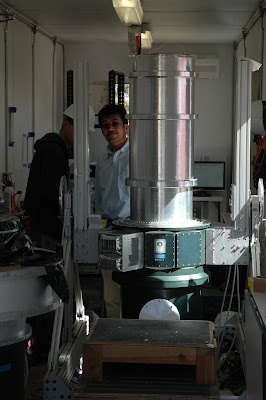Mono Lake from route 395

Paul arrived, and got to work implementing his front
mounted ladder which is anchored at the ground
and attaches to the telescope to get into the boom area.
Look, ma, no hands!

Dave got his his turn at ringing the bell.
Close, but no cigar.
Takayuki arrived and here he is working
on the receiver.
Wrestling the radiation shields in.
Kam , Paul, Daniel, and Dave installing safety rails and floor into
the telescope.
Dave working on the receiver hoist hardware.
Installing the radiation shields onto the
receiver.
The receiver just fits through (after
you remove the door).
In a few years, everyone will be
doing the hardhat-suspenders-booties-latex
gloves-unshaven look. You saw it here
first.
Nothing like a new fresh sticky mat
Kam driving the manlift. Take note his birthday will
be coming up sooner than you think. But where to park
it in Berkeley...
Peter arrived this week and is working on receiver
assembly here.
Another Peter action shot. He can swing a mean allen key.
Peter and Ziggy putting on the 50 K
radiation shields.
Bryan and Takayuki testing the pulse tube cooler before installation.
Bryan working on the pulse tube cooler.
Daniel, Peter, and Marius weatherproofing the electronics
boxes.
We had some problems getting the water chiller for the
pulse tube compressor to work. Tony came by and
installed a fan regulator and recharged the compressor.
Much better!
Chase running ethernet through the cable wrap.
Takayuki installing cables in the azimuth cable wrap.
Dave and Marius installing the receiver hoist.
There are eleven of us here now. Many parallel projects
on the telescope and receiver.
Paul brought his own Skilsaw
Half-wave plate rotator
Removing a press fit pin that is in the way.
finally!
Kam and Dave working on safety rail installation. After
some cold windy weather and some snow, we're having
a period of warm still weather.
Kam and Dave enjoy the view from the telescope
Nils bought a theodolite to align
the mirrors and receiver. It measures
angles to 5 arc seconds. Peter trys it out.
Paul and Dave Woody
Paul working on a pipe for the safety rail
Paul shows off the safety rail
Peter working on the electronics boxes
Ziggy starting the pulse tube cooler installation in the receiver.
Takayuki gets the pulse tube cooler
ready.
A late night effort from Ziggy, Takayuki,
and Bryan and the dewar is closed and
pumping.
 This valve shuts off the flow to the water pump, so that you can disconnect the device you're cooling water for. It now only closes to the point of the chiller drooling like an old dog.
This valve shuts off the flow to the water pump, so that you can disconnect the device you're cooling water for. It now only closes to the point of the chiller drooling like an old dog.















































































